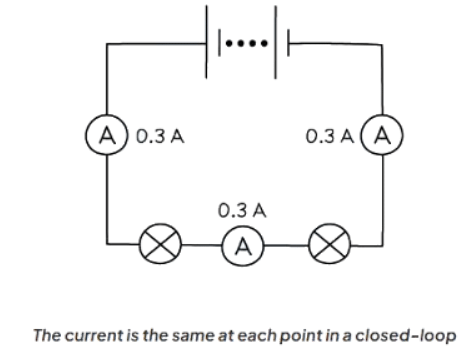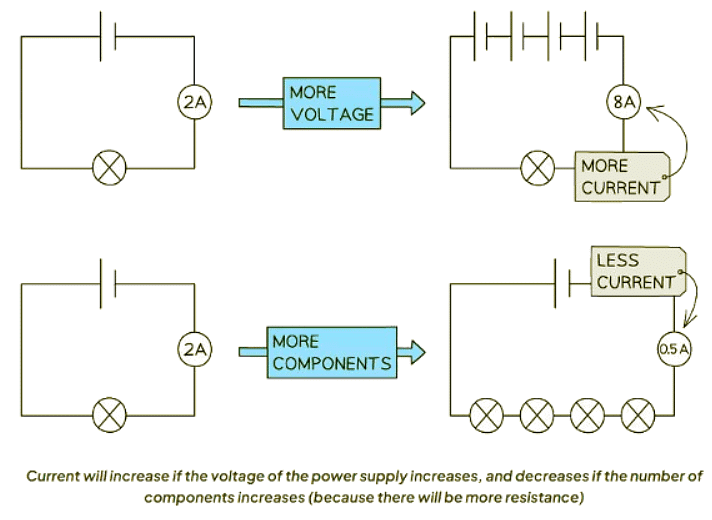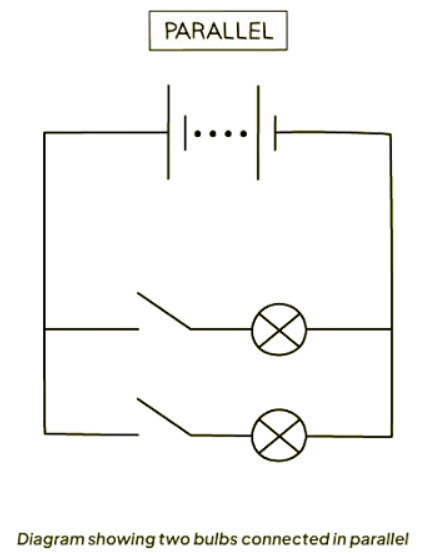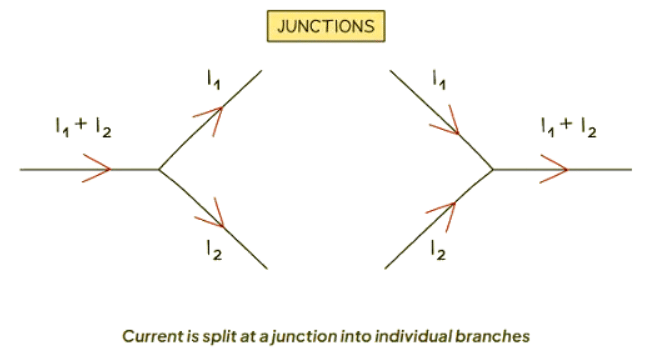Class 10 Exam > Class 10 Notes > Physics for GCSE/IGCSE > Current in Circuits
Current in Circuits | Physics for GCSE/IGCSE - Class 10 PDF Download
Current in Series Circuits
- In a closed-loop circuit like a series circuit, the current remains constant throughout.
- This consistency arises from the fact that the quantity of electrons flowing through any segment per second equals that flowing through any other part.
- Consequently, all elements within a closed-loop exhibit identical current.

- The quantity of current circulating through a series circuit is contingent on two key factors:
- The voltage of the power source
- The resistance of the circuit components
- Higher voltage from the power source results in increased current flow within the circuit.
- Decreasing the voltage from the power source leads to a reduction in current.
- Increasing the number of components in the circuit raises the total resistance.
- Thus, the circuit experiences a decrease in current flow.

Current in Parallel Circuits
- Parallel circuits involve multiple components connected in separate branches.

- The advantages of parallel circuits include:
- Components can be controlled individually via their own switches.
- If one component malfunctions, the others can continue operating.
- Current divides in a parallel circuit, with portions flowing through different branches.
- As a result, the current in each branch is less than that from the power supply.
Question for Current in CircuitsTry yourself: What factors determine the quantity of current in a series circuit?View Solution
Junctions in Parallel Circuits
- At a junction within a parallel circuit, where multiple wires intersect, the principle of current conservation applies.
- This implies that the incoming current at the junction equals the outgoing current.
- This conservation principle arises from the fact that charge remains constant.
- It's important to note that current distribution may not always be uniform; certain branches may carry more current than others. Uniform current distribution occurs only when the resistance across each branch is identical.
- The behavior of current is governed by the flow of electrons, which are physical entities subject to the law of conservation of matter.
- Therefore, the total number of electrons, and consequently the current, within a circuit remains constant.
- Upon reaching a junction, electrons diverge, with some electrons moving in one direction and the remainder in another.

The document Current in Circuits | Physics for GCSE/IGCSE - Class 10 is a part of the Class 10 Course Physics for GCSE/IGCSE.
All you need of Class 10 at this link: Class 10
|
126 videos|182 docs|35 tests
|
FAQs on Current in Circuits - Physics for GCSE/IGCSE - Class 10
| 1. What is the relationship between current and resistance in a series circuit? |  |
Ans. In a series circuit, the current remains the same throughout the circuit as it has only one path to flow. The relationship between current and resistance in a series circuit is described by Ohm's Law: V = IR, where V is the voltage, I is the current, and R is the total resistance in the circuit.
| 2. How does the total current change when resistors are added in series? |  |
Ans. When resistors are added in series, the total resistance in the circuit increases. According to Ohm's Law, since the total resistance increases, the total current in the circuit decreases. This is because as resistance increases, it becomes harder for current to flow through the circuit.
| 3. What happens to the current in a series circuit if one of the components fails? |  |
Ans. If one component in a series circuit fails (e.g. a resistor burns out), the current in the entire circuit will stop flowing. This is because in a series circuit, the current must pass through each component sequentially, so if one component is not functioning, the circuit is broken.
| 4. How does the total current in a parallel circuit compare to a series circuit? |  |
Ans. In a parallel circuit, the total current is divided among the branches of the circuit, unlike in a series circuit where the current remains the same throughout. This means that the total current in a parallel circuit is equal to the sum of the currents in each branch.
| 5. Can the total current in a circuit be greater than the current supplied by the voltage source? |  |
Ans. No, the total current in a circuit cannot be greater than the current supplied by the voltage source. According to Kirchhoff's Current Law, the total current entering a junction in a circuit must be equal to the total current leaving the junction. Therefore, the total current in a circuit is limited by the current supplied by the voltage source.
Related Searches




















